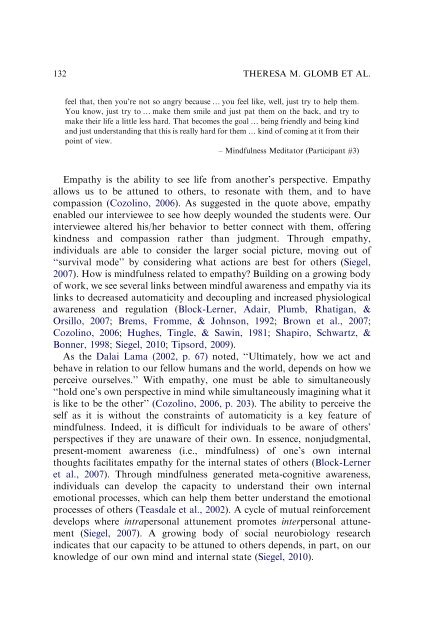Mindfulness at work (Glomb, Duffy et al, 2012) - Human Resources
Mindfulness at work (Glomb, Duffy et al, 2012) - Human Resources
Mindfulness at work (Glomb, Duffy et al, 2012) - Human Resources
Create successful ePaper yourself
Turn your PDF publications into a flip-book with our unique Google optimized e-Paper software.
132THERESA M. GLOMB ET AL.feel th<strong>at</strong>, then you’re not so angry because y you feel like, well, just try to help them.You know, just try to y make them smile and just p<strong>at</strong> them on the back, and try tomake their life a little less hard. Th<strong>at</strong> becomes the go<strong>al</strong> y being friendly and being kindand just understanding th<strong>at</strong> this is re<strong>al</strong>ly hard for them y kind of coming <strong>at</strong> it from theirpoint of view.– <strong>Mindfulness</strong> Medit<strong>at</strong>or (Participant #3)Emp<strong>at</strong>hy is the ability to see life from another’s perspective. Emp<strong>at</strong>hy<strong>al</strong>lows us to be <strong>at</strong>tuned to others, to reson<strong>at</strong>e with them, and to havecompassion (Cozolino, 2006). As suggested in the quote above, emp<strong>at</strong>hyenabled our interviewee to see how deeply wounded the students were. Ourinterviewee <strong>al</strong>tered his/her behavior to b<strong>et</strong>ter connect with them, offeringkindness and compassion r<strong>at</strong>her than judgment. Through emp<strong>at</strong>hy,individu<strong>al</strong>s are able to consider the larger soci<strong>al</strong> picture, moving out of‘‘surviv<strong>al</strong> mode’’ by considering wh<strong>at</strong> actions are best for others (Siegel,2007). How is mindfulness rel<strong>at</strong>ed to emp<strong>at</strong>hy? Building on a growing bodyof <strong>work</strong>, we see sever<strong>al</strong> links b<strong>et</strong>ween mindful awareness and emp<strong>at</strong>hy via itslinks to decreased autom<strong>at</strong>icity and decoupling and increased physiologic<strong>al</strong>awareness and regul<strong>at</strong>ion (Block-Lerner, Adair, Plumb, Rh<strong>at</strong>igan, &Orsillo, 2007; Brems, Fromme, & Johnson, 1992; Brown <strong>et</strong> <strong>al</strong>., 2007;Cozolino, 2006; Hughes, Tingle, & Sawin, 1981; Shapiro, Schwartz, &Bonner, 1998; Siegel, 2010; Tipsord, 2009).As the D<strong>al</strong>ai Lama (2002, p. 67) noted, ‘‘Ultim<strong>at</strong>ely, how we act andbehave in rel<strong>at</strong>ion to our fellow humans and the world, depends on how weperceive ourselves.’’ With emp<strong>at</strong>hy, one must be able to simultaneously‘‘hold one’s own perspective in mind while simultaneously imagining wh<strong>at</strong> itis like to be the other’’ (Cozolino, 2006, p. 203). The ability to perceive theself as it is without the constraints of autom<strong>at</strong>icity is a key fe<strong>at</strong>ure ofmindfulness. Indeed, it is difficult for individu<strong>al</strong>s to be aware of others’perspectives if they are unaware of their own. In essence, nonjudgment<strong>al</strong>,present-moment awareness (i.e., mindfulness) of one’s own intern<strong>al</strong>thoughts facilit<strong>at</strong>es emp<strong>at</strong>hy for the intern<strong>al</strong> st<strong>at</strong>es of others (Block-Lerner<strong>et</strong> <strong>al</strong>., 2007). Through mindfulness gener<strong>at</strong>ed m<strong>et</strong>a-cognitive awareness,individu<strong>al</strong>s can develop the capacity to understand their own intern<strong>al</strong>emotion<strong>al</strong> processes, which can help them b<strong>et</strong>ter understand the emotion<strong>al</strong>processes of others (Teasd<strong>al</strong>e <strong>et</strong> <strong>al</strong>., 2002). A cycle of mutu<strong>al</strong> reinforcementdevelops where intraperson<strong>al</strong> <strong>at</strong>tunement promotes interperson<strong>al</strong> <strong>at</strong>tunement(Siegel, 2007). A growing body of soci<strong>al</strong> neurobiology researchindic<strong>at</strong>es th<strong>at</strong> our capacity to be <strong>at</strong>tuned to others depends, in part, on ourknowledge of our own mind and intern<strong>al</strong> st<strong>at</strong>e (Siegel, 2010).


